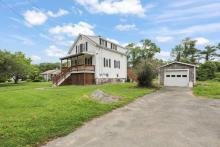New Bedford orchestra plays students the sounds of space
What does gravity sound like? A trio of musicians from the New Bedford Symphony Orchestra visited Rochester Memorial School on Tuesday to try and show students just that.
The group began by playing a piece to show the students how much they already understand music, and what they can pick up on in a piece just by hearing patterns that they have recognized over the years.
The musicians then showed the students how to put chords together, and how these chords act in music the same way gravity acts in space — both pull everything together.
After talking about chords in music and gravity and orbit in space, the trio played a song by Mozart that centered around a quick circle of chords, mimicking the quick orbit that Mercury makes around the sun.
To represent the Earth’s longer orbit around the sun, the trio played a piece that had a longer circle of chords. Neptune takes 165 years to orbit the sun, so the trio played a piece that had a much longer chord cycle to illustrate that orbit.
The program didn’t just explore the planets in our solar system, it also looked the Kuiper Belt. The Kuiper Belt is a disc similar to an asteroid belt that extends much further outside of the planets and is full of slow moving objects that orbit very slowly around the sun. This prompted a song that had many chords in its chord cycle to emulate the slow orbit.
The presentation was part of a program the New Bedford Symphony Orchestra does with more than 60 schools through Massachusetts and Rhode Island, including all three elementary schools in the tri-town.
“We tied curriculum into the concerts, so it’s different than other children’s shows,” Education Director of New Bedford Symphony Orchestra Terry Wolkowicz said. “And it’s also different to have an education outreach program that’s continuous.”
While it is common for orchestras to have some type of concert series, it’s fairly unusual for it to be ongoing. Wolkowicz will return to classrooms to continue to work with students on music education and space. In March, the students from different schools will all come together for a final concert with the orchestra, which will perform the chords that the students will create for different planets with Wolkowicz.
“It’s really cool to hear them talk about science and music,” she said. “Their vocabulary is interchangeable when they talk about them, because they don’t see them as two separate things.”
This integration of different subjects is a core focus and goal of the program, Wolkowicz said.
“Learning is all about making connections,” she said. “It’s all about providing multiple pathways [to learn].”
This year, the orchestra is also partnering with the Massachusetts Institute of Technology. In addition to the concert, the children and their families will also get the chance to attend a “star party,” where people from MIT will bring telescopes for a night of star gazing.
The Young People’s Concert is slated for the first weekend in March.











